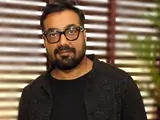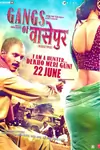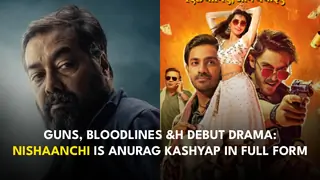5 Anurag Kashyap films that remain unforgettable - From 'Gangs of Wasseypur' to 'Dev D' & more
Steering away from obvious titles like Paanch, Black Friday and Gulaal which already enjoy cult status, we dive into five films that best reflect Kashyap’s distinct approach.
Published: Thursday,Aug 21, 2025 13:45 PM GMT-06:00

Few Indian filmmakers have managed to consistently shake up cinema quite like Anurag Kashyap. He has built a reputation as someone who does not simply tell stories but dissects the human condition through them. His films often explore the mechanics of greed, survival, longing, and power, making audiences sit uncomfortably close to realities that are usually brushed aside.
Now, with his upcoming directorial Nishaanchi, Kashyap is once again ready to walk into uncharted territory. The film, backed by Amazon MGM Studios, follows the lives of two brothers who make starkly different choices. Their journeys, anchored in a rustic Indian heartland, explore the messy consequences of love, ambition, and morality colliding. With a release date set for September 19, expectations are mounting for how Kashyap will reframe familiar tropes through his unfiltered lens.
This moment makes it ideal to revisit some of his most impactful works that shaped contemporary Indian cinema. Steering away from obvious titles like Paanch, Black Friday and Gulaal which already enjoy cult status, we dive into five films that best reflect Kashyap’s distinct approach. These films combine mainstream appeal with his subversive storytelling, offering audiences a mix of grit, complexity, and resonance.
Gangs of Wasseypur Part 1 and Part 2
https://www.youtube.com/watch?v=5oRczmZ6dGUNo conversation about Kashyap is complete without Gangs of Wasseypur. Released in two parts, the saga cemented his reputation as a master storyteller willing to take risks others would not. What looked like a gangster drama on the surface quickly turned into a multi-generational epic. The film was sprawling, unapologetic, and layered, weaving together revenge, greed, and survival in the coal belt of Dhanbad.
Characters like Sardar Khan, Faizal Khan, and Ramadhir Singh became cultural shorthand for power struggles. Each embodied not just individual motivations but archetypes of ambition and betrayal. Kashyap’s fearless approach to language, politics, and violence gave the film a raw pulse that audiences had rarely encountered before.
Beyond the surface of blood and bullets, the Wasseypur saga captured the slow corrosion of morality across decades. It revealed how generations inherit not just names and legacies but grudges and hatreds. The soundtrack, dialogues, and stylistic choices blended into a package that turned the film into more than entertainment. It became a social document disguised as a revenge thriller.
Even today, memes, quotes, and references from the film circulate widely, proving that Wasseypur continues to dominate conversations long after its release. It showed Indian cinema that mainstream films could be fearless without losing audiences.
Raman Raghav 2.0
https://www.youtube.com/watch?v=xq1cEmhVa68If Wasseypur was sprawling and panoramic, Raman Raghav 2.0 was intimate and suffocating. The film took inspiration from the notorious Mumbai serial killer Raman Raghav but shifted into a psychological exploration rather than a biopic. It introduced audiences to a murderer and a cop, both flawed and broken in ways that mirrored each other.
The serial killer, played with unnerving calm, embodied obsession and control. The cop, on the other hand, was equally unstable, hiding his addictions and vulnerabilities beneath the uniform. Kashyap blurred the line between who was hunter and who was prey, leaving audiences unsettled.
The power of the film lay in its refusal to comfort. It dragged viewers into the grime of Mumbai’s underbelly, not with sweeping shots but with claustrophobic intensity. The narrative suggested that evil is not always external but often lies buried within the very systems meant to protect.
Raman Raghav 2.0 became one of Kashyap’s most provocative films because it demanded that viewers confront the darkness they usually avoid. Instead of a clear moral compass, it presented a distorted mirror where no one emerged unscathed.
Dev D
https://www.youtube.com/watch?v=9UVZprrlvtwLong before contemporary cinema embraced reinventions, Kashyap took on one of the most retold stories in Indian literature. Dev D reimagined the tragic tale of Devdas for a modern world. But instead of ornate sets and theatrical melodrama, Kashyap stripped it down to urban angst and raw human frailty.
Dev became a man consumed by heartbreak and reckless self-destruction. Paro was reimagined with agency and fire, while Chanda was given a layered backstory that challenged the archetype of the fallen woman. Each character felt flawed but deeply human, embodying desires and vulnerabilities that audiences could relate to.
The film was revolutionary in the way it used music and visual style. Its soundtrack became anthemic, cutting across audiences who might never have imagined listening to a Devdas retelling on loop. The colour palette, editing, and cinematography embraced experimentation without losing accessibility.
What made Dev D truly significant was its refusal to glorify suffering. It showed addiction, obsession, and heartbreak with unflinching honesty while also allowing redemption. For an entire generation, the film became not just a reworking of a classic but a cultural reset on how love stories could be told.
Manmarziyaan
https://www.youtube.com/watch?v=ToxnuakJrqEWhile Kashyap had built a reputation on crime and grit, Manmarziyaan revealed another side of him. At its core, the film was about love and choice, but its execution turned it into a layered meditation on how people navigate emotions in a complicated world.
The story followed Rumi, Vicky, and Robbie, three individuals bound by passion, loyalty, and circumstance. Kashyap allowed each character to breathe in their contradictions. Rumi was impulsive yet vulnerable. Vicky carried chaos yet also depth. Robbie seemed stable but harboured his own complexities.
What set Manmarziyaan apart was its ability to treat love not as a formula but as an evolving state of being. The film thrived on moments of silence, hesitation, and conflict, proving that Kashyap could handle intimacy with as much precision as violence.
The music, crafted by Amit Trivedi, became an integral part of the narrative. Songs did not just decorate scenes but advanced emotions, often giving insight into what characters could not say aloud.
By the end, Manmarziyaan left viewers reflecting on how choices in love are rarely clean, and how the messiness of desire often shapes who we become.
Mukkabaaz
https://www.youtube.com/watch?v=fl3gun0J8XMWith Mukkabaaz, Kashyap turned to sports as an entry point to examine larger social issues. On the surface, it told the story of an aspiring boxer trying to rise through the ranks. But the narrative quickly expanded to reveal caste hierarchies, systemic corruption, and personal sacrifice.
The protagonist’s fight was not just against opponents in the ring but against entrenched injustice outside of it. Coaches, federations, and family structures all became obstacles, reflecting how dreams often collide with social realities in India.
Kashyap balanced the underdog arc with sharp commentary. Every punch thrown in the ring carried the weight of battles fought outside it. What could have been a predictable sports drama instead turned into a layered reflection on resilience and injustice.
The film also showcased Kashyap’s ability to merge genres. It worked both as a sports narrative and as a social critique, proving that mainstream storytelling can carry depth without losing entertainment value.
From the sweeping saga of Wasseypur to the intimate chaos of Manmarziyaan, Kashyap’s defining strength has always been his creation of characters and worlds that linger long after the credits roll. His upcoming film Nishaanchi promises to extend that legacy.
If history is any indicator, Nishaanchi will not just be a film but an experience that provokes conversation. Whether it matches the cult status of Wasseypur or the reinvention of Dev D remains to be seen, but the anticipation is proof that Kashyap has built a trust with audiences who expect to be challenged as much as entertained.
If his track record is any guide, his new film will not just add to his filmography but will expand the conversation about what Indian cinema can achieve.
Few filmmakers push boundaries like Anurag Kashyap, whose cinema digs into survival, morality, love, and power. With his new film Nishaanchi arriving September 19, the moment feels right to revisit five works that defined his style, from Wasseypur’s sprawling revenge saga to Mukkabaaz’s underdog grit. Each reveals why Kashyap continues to reshape Indian storytelling. Read full feature.
Join Our WhatsApp Channel
Stay updated with the latest news, gossip, and hot discussions. Be a part of our WhatsApp family now!
Join NowYour reaction
 Nice
Nice Great
Great Loved
Loved LOL
LOL OMG
OMG Cry
Cry Fail
Fail






















Post a comment